We celebrate Korea with a focus on Korean artists in this issue. This also marks our first Korean language issue distributed in Korea. We are very excited to share Ensemble Magazine with an increasingly broader audience. We are also excited and proud to share stories about Korean art and culture in this and coming issues.
South Korea, though roughly the size of the state of New Jersey, is the 4th largest economy in Asia and the 11th largest in the world with a population exceeding 50 million in 2012. The entire country would fit into the area between San Francisco and Los Angeles California.
This tiny space is famous for, among many other things, a cuisine distinguished as among the most healthful and flavorful in the world. Tasty dishes with some spicy enough to make one’s ears spin are perhaps an example of a culture which produces great treasures, innovations, and creativity in an exemplary manner for the benefit of the world at large.
We take great pleasure in introducing several wonderful Korean artists who are just an example of a thriving artistic community in whom the country takes great pride.
Artists featured:
Jae Hoon Lim | Olivia Choi | Young Bin Cho
Sang Woo Shin | Hyun Seo Cho | Soo Dong Lee
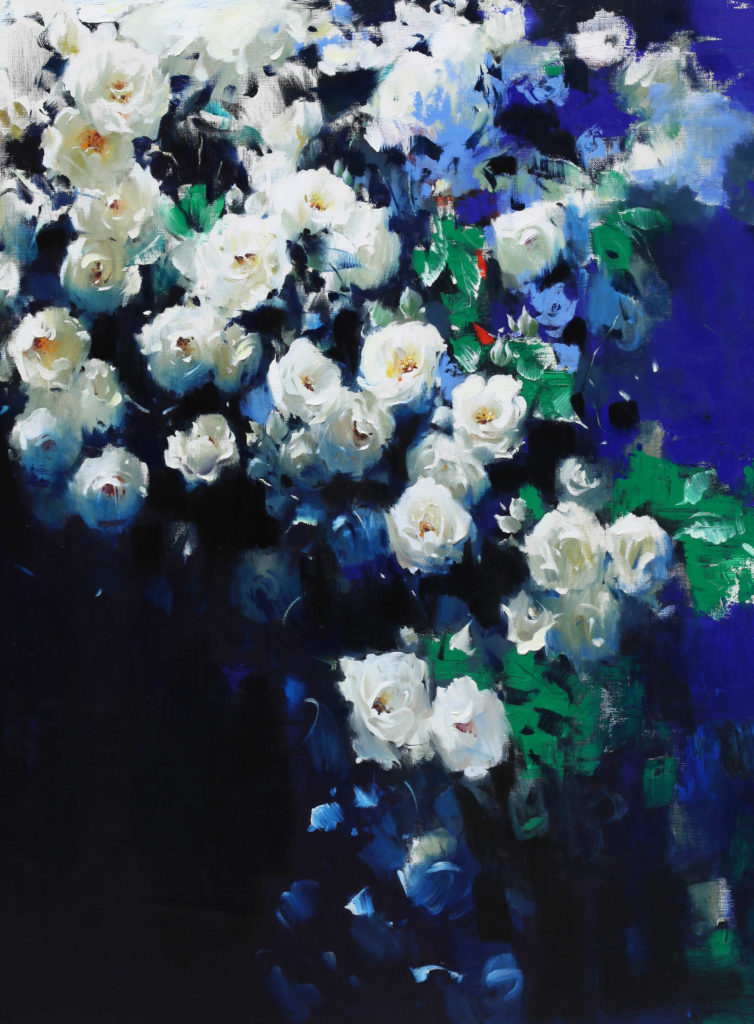
Jae Hoon Lim
Chosun University 1991 – BFA, MFA in painting
Exhibited works in Korea and Internationally since 1990
We begin to consider the work of Jae-Hoon Lim with this beautiful depiction of roses (see painting above). Roses are a universally pleasing subject for the painter and audience. Such floral representations are easily created and recreated by master and student alike to the great appreciation of the viewer. So what is it which distinguishes the technically proficient work from the subtleties of the master’s hand and eye?
Zhu Jing Xuan’s book, Tanchao Minghua Lu, written to describe works of the Tang Dynasty, critiques works of artists on the basis of four categories: Divine, Extraordinary, Professional, and Mediocre. To capture the category of Divine work, the artist must surpass simple technical excellence and infuse the work with something intangible yet perceptible to the viewer.
Mr. Lim, in painting roses, captures a sense of the movement, a swirling mountain wind which animates the scene and, almost as an optical illusion, there is a volume and dimension to the work which brings depth and compassion. The fragrance of the roses is conveyed by the memories and associations of the artist in the creative process. The crisp morning air carrying the fragrances and cacophony of sounds of the bustling dawn flower market are conveyed from brush to canvas along with the associative memories surrounding the scene.
In all of Mr. Lim’s work, there is a sense of the emotion and memory which influences the portrayal of image. A horse-drawn carriage moving away from us in the gloom of a rainy street, warmed by golden lamplight. Dark, indistinct figures, self-absorbed as they hurry to cross the street as traffic approaches in an explosion of color. A crowded train platform, filled with figures and the undefined drama of waiting expectantly as a train arrives to carry them away.
Whether a cluster of roses, a street scene, or a portrait, Mr. Lim’s works leave us with a sense of an experience, a journey, unfolding before us.
Olivia Choi
Graduate Hongik University BA, MA Fine Arts
Stanford University Master Program Advanced Painting
Exhibited in Korea and Internationally
Shortly before his passing, I went to visit Kwon, Ok-Yeon, the great Korean artist. When I arrived at his home, he was at work in his studio. Though feeble in age, he continued his creative work and I was deeply honored that he made his way with difficulty to greet and visit with me. In the course of our talk, he told me; “You should meet a person who has a dream and lives that dream. Artists are special people. You should make your dream become your world at all times and seek the person who inspires your dream.”
 Dreaming of You, Oil on Canvas by Olivia Choi
Dreaming of You, Oil on Canvas by Olivia Choi
At that time, I felt that I had met this person, Kwan, Ok-Yeon inspired my dream and my work from that day. As an artist and a treasure for Korea, his legacy lives on and for me, his inspiration informs my life and work.
In my creative process, I am seeing myself when looking at a painting. I do not just paint what my eyes behold but allow myself to imagine and express the inspiration I receive from the spirit of what I observe. As spectators, we can feel the world beyond what we see in the moment, we can share too, what we receive through the spirit of our imagination. Whether seeing an object in its tangible realm or seeing it in the context of everything which is evoked by that object, we can enter into that new world through experiencing the paintings.
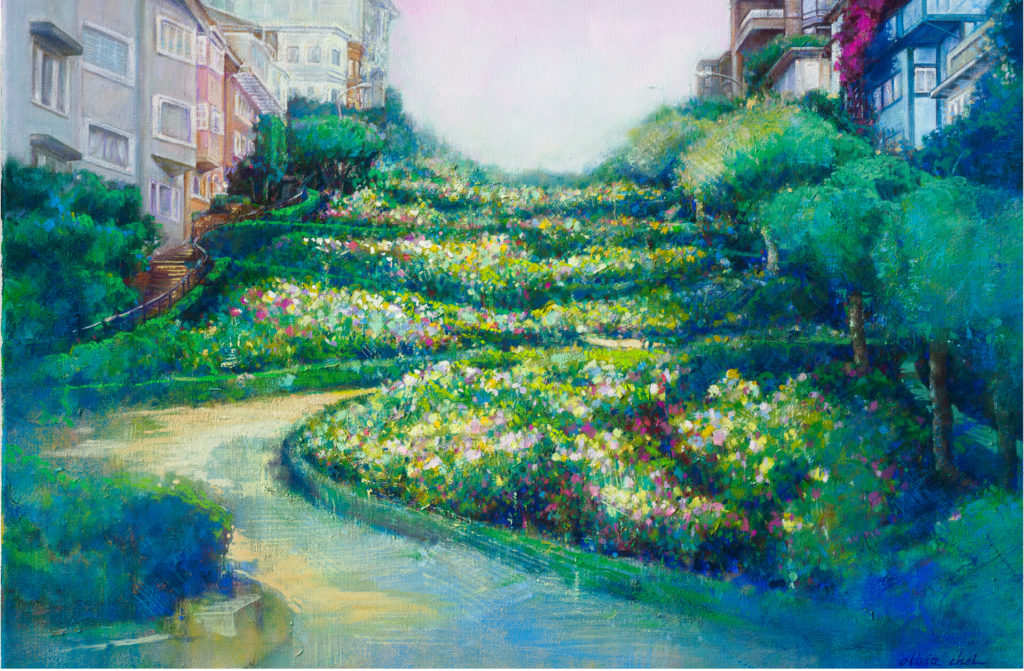
The light and space in my paintings are as important to me as the objects. The light and empty spaces are there to be filled by the observer. Sometimes by sorrow, or joy, fragments of things past evoked by the light in the painting which reminds us always to be present and awake.
We chase the emptiness, like Oedipus who could see the truth only after blinding himself, and find the fragments of things remembered which shift unpredictably and form into meaning.
I want my work to reflect not only the presence of things but the absence as well. I enjoy creating pairs of works, images like in a parallel world in which the absence of something in one world determines its presence in another world. We are waiting and longing for what is felt but not seen. I want my work to lead me to the unseen world.
In my piece, Dreaming of You, I portrayed the cherry blossoms and unicorn. The perfection of the cherry blossom in nature is a moment we await with longing, a brief time which comes and goes, a moment of absolute perfection and in viewing the blossoms’ graceful flight, we find peace and joy. The unicorn is the essence of ourselves through which we can truly experience these beautiful moments. I see the unicorn as a spirit totem to lead me through the world of dreams.
In my work, I also paint scenes from the everyday world. I choose subjects which represent a bridge to the dream world; moments, places, people, which open the door to my inner world. I often paint human figures from the back and leave empty spaces, empty streets, in the portrayals of space to allow for the unexpected and unknown to enter.
I hope my work opens the doorway for others to enter their dreams and experience moments of freedom.
Young Bin Cho
Born in Seoul Korea, Ms Cho was graduated from the prestigious Hongik University. She works in the medium of printmaking. Her work, inspired by the nurturing influences of nature, ranges from the realism of still life floral representations to playful surreal imagery. Her works have been exhibited throughout Korea.
ENSEMBLE: How do you describe your work? Is there a constant theme or thread which follows your work?
My work has been inspired by objects in nature, flowers, trees, and oceans since my early experience as an artist. I am inspired by the powerful calming and stabilizing influences of nature which surround me. This influence brings me a sense of peace which I want to share through my work.
ENSEMBLE: What are your preferred media?
I love to work with the wide variety of printing techniques and media. There is a detailed process to prepare for the print, often highly detailed and carefully controlled. But then, at the final moment of creation, the printing process introduces some unpredictable results adding an element of surprise and delight that speaks to the intimate influence of nature and its hand in my work. Just as in the world of nature, there are many things we attempt to control but in the end, nature asserts herself in subtle and dramatic ways.
ENSEMBLE: Are there specific influences or experiences which you feel strongly influence your work?
Not particularly. My work is like me. I think I am a simple, grounded person. I am happiest when surrounded by the influence of the beauty of nature and the precious warmth of loved ones and friends. These are simple joyful things I want to express and share in my work. Some artists are highly sensitive about things, cynical, passionate about societal or personal struggles perhaps, and want to make statements in their work which respond to these things. My life has a peaceful serenity, my work is influenced by my inner sense of quiet calm, my works with flowers for example, come from a desire to share the simple miraculous beauty with others.
ENSEMBLE: How do you experience yourself as a Korean artist emerging out of an education and grooming in western methods?
When I observe western art, the historic great works as well as the great contemporary works, I feel a sense of stress or unease which I do not feel when I view traditional great works of Korean art. The art of my culture makes me feel joyful. Yet we live in a world increasingly influenced and dependent upon western ideas, perspectives and technology. My training is steeped in western forms and techniques. Finding my Korean self-expression in an evolving global community is often difficult. At times I do not know really what Korean style is or how it manifests itself. Like so many artists, I often use photography in the creation of my pieces. Photography is a western tool, yet working from photography has become prevalent among artists of all cultural backgrounds. From time to time I do glimpse my essential Korean nature manifesting in my work. Western composition is very three-dimensional. I find that my work follows a more traditional Korean composition which emphasizes the gradations of white, gray, and black to create dimension rather than the western use of colors. there is a subtlety in gradations of light and dark which is lost in the use of rich colors. Though the use of color brings deep dimension and texture, the traditional Korean methods express this more suggestively, quietly, yet not less powerfully.
ENSEMBLE: Is there a piece which especially expresses your character as an artist? Tell us how that piece evolved and why it is especially significant to you.
The Purple Wave. I feel as though it is my first work. Although I did many pieces before this one, The Purple Wave is the first piece which is truly mine, my expression, my technique. So this piece is special to me because it represents my birth as an artist of unique expression.
ENSEMBLE: Looking at your work, I see an interesting variety of subjects and technique, what influences you to create this diversity of image?
I always consider myself a beginner, always trying new things. Over time, I continue to refine my mastery of printing techniques. Each method, lithograph, monograph, etc produce different results and this guides me in the sort of subject I create.
For the Purple Wave, I used lithography. It produces a fine texture and detail which I enjoyed in the creation of this piece.
Flowers on the Ground is a monotype with oil and water. In general, I prefer monotype for my flowers because it conveys the soft texture and gentle beauty of flowers.
Illusion. Lithograph. I saw a winter landscape and felt that I wanted to escape to this beautiful place. I had some spontaneous sense of a winter rabbit and one rabbit seemed too lonely.
Sitting in Nowhere Land. Lithograph. Our world is full of constant conflict and we want to flee from the noise and strife. So I created this quiet place in the forest. The white is an absence of color, an element of peace in this scene.
Sang Woo Shin
Ph. D Department of printmaking, The Graduate School of HongIk University, Korea
M.F.A Department of printmaking, The Graduate School of SUNY at NewPaltz, U.S.A)
M.F.A Department of printmaking, The Graduate School of HongIk University, Korea
B.F.A Department of printmaking, HongIk University, Korea
B.F.A Department of Fine Arts Education(Painting), SeoWon University, Korea
Dr. Shin works in the medium of printmaking and has distinguished himself in a long list of solo and group exhibitions around both in Korea and internationally.
ENSEMBLE: Tell us about your Modern People series.
We exist in a world of ambiguous values, often contradictory, like both hope and anxiety. We adapt to our given surroundings and in the process, we manifest a self which is highly determined by the “reality” around us. Without realizing, gradually the external overwhelms the inner world and we struggle to find who we are in a world of masks and multiple personalities. My work with Modern People intends to bring a release to the inner world and suppressed internal desires through the freely transformed and distorted figures in my work. These forms express my artistic mission to elicit a joyful vicarious pleasure and empathy within others.
The mask-like faces represent the duality in the lives of modern people. We display pretentious facial expressions with our masks and hide behind them our more genuine faces. The contrast between what we display of ourselves within social norms and our desire to deviate from those norms is represented in the divided composition of the work and is reproduced and expanded into other forms.
I sub-title my work Modern People as Modern People – A Coexistence, Modern People – Happy Imagination, Modern People – Exotic Night, etc., in representation of the forms I see in which we adapt and manifest in the modern world.
The characters in my work are somewhat exaggerated. I create them this way to convey instantly their essential character and, through overstatement, I stress the irony and reveal the pleasure they create; even the pleasure I take in creating them. My work reminds people of a laboratory for the research of facial expressions full of exaggerated gestures, gaping mouths, stunned and spinning eyes, and clownish features.
Hyun Seo Cho
ENSEMBLE: How do you describe your work? Is there a constant theme or thread which follows your work?
My work is about relationships. My focus includes how barriers such as distance and time affect relationships differently today than in the past, as well as the relationship between people and the intangible, and the relationship between humans and nature. These relationships are affected by a person’s experiences and evolving outlook of the world.
I aim to learn more about my relationship with myself, while simultaneously developing existing relationships and forging new relationships.
I use various artistic methods – such as painting, drawing, sculpture and machine drawing – to explain myself and other people’s stories. I attempt to create more relationships to help understand the chaos and drifting faith in this uncertain world, and aim to overcome the fear of the unknown.
ENSEMBLE: What are your preferred media?
There is no limit when it comes to art mediums. I begin each piece of work by deciding what I would like to convey through my art and then select art mediums that can well represent and express my ideas and thoughts. The choice of art mediums is always open.
ENSEMBLE: Are there specific influences or experiences which you feel strongly influence your work?
For many years I have thought about how to manifest what I would like to convey through my creativity. Such periods of reflection helped foster the inspiration behind my personal “machine drawing” technique.
This technique highlights modern technology instead of drawing techniques rooted in the past.
I came up with the “machine drawing” technique idea while I taught a fashion design course at a university for several years. I became inspired when the students made garments by using industrial sewing machines.
Using an industrial sewing machine as the brush and pen, and thread as pigments, I draw facial expressions and body gestures of modern people by employing various thicknesses of thread and controlling the speed of the industrial sewing machine.
Sewing has been around from the advent of human civilization. Even though nowadays a sewing machine is perceived as a classic and traditional machine, I enjoy using it as a metaphor of the mechanized era.
Sewing machines are the product of a cold, modern technology that excludes emotion and subjectivity. However, the most individual and subjective way to expose an artist’s emotion instantly is through drawing. The dramatic encounter of these two expressive styles (industrial sewing machines and drawing) is a methodology to symbolize the breathing and emotions of people living in a mechanical civilization that excludes subjectivity. The combination of these two styles also has the meaning of continuation and healing.
My “machine drawing” technique requires skills from labour-intensive work. But, ironically, my time and physical effort to develop these skills also served as periods of personal meditation.
ENSEMBLE: How do you experience yourself as a Korean artist emerging out of an education and grooming in western methods?
I think all direct and indirect experiences are important for me, such as books, films, simple stories, brief moments of inspiration, and so on. These are all my components. Therefore, all of these emotional charges and pain are the nourishment of my artwork. More specifically, Laozi (an ancient Chinese philosopher), Gilles Deleuze (a French philosopher), Martin Heidegger (a German philosopher) and Louise Bourgeois (a French-American artist) amaze me with how they approach, express and solve the problem of trauma through their work. It is not possible to mention every person from whom I have become inspired; I feel that I have been inspired by so many people in a multitude of ways.
ENSEMBLE: Is there a piece which especially expresses your character as an artist? Tell us how that piece evolved and why it is especially significant to you.
As I mentioned, my intention is to reflect on various relationships, such as the relationship between people, the relationship between humans and nature, and the relationship between the individual and society, through my creative work style.
ENSEMBLE: Looking at your work, I see an interesting variety of subjects and technique, what influences you to create this diversity of image?
I am a PhD candidate in fine arts at Dong-a University (Busan, South Korea). I obtained an MA degree and a BA degree in fine arts from the same university.
Communicating with other people often causes me difficulties. It made me think about the relationship between people, and extended my early thoughts towards other relationships in a much wider prospective, such as the relationship between humans and nature, and the relationship between the individual and society. These thoughts are the background of my art subject.
Relationships between humans are inevitable, even between people who are inherently introverted and would prefer to limit such interaction. Relations between family members and generations have changed rapidly among a tide of rapid and diverse social changes. Modern people continue solving life’s daily challenge on a daily basis by understanding and managing the safe distance between the relationships as defensive instincts from previous trauma, like the hedgehog’s dilemma story from Parerga and Paralipomena by Arthur Schopenhauer (a German philosopher).
Although we enjoy a plenitude of material wealth compared to past eras, today’s modern people face a destitute loss of identity from the crisis in their individual identity.
Therefore, in our modern, diversified society, an individual human’s facial expressions and body gestures are meaningful because they reflect all aspects of relationships, given that individuals are a part of a greater whole. Human relationships in this present era remind me of the Indramang principle from Buddhist philosophy. There is a moment when human beings realize that there is nothing existing for them in life.
I do not want to jump to a conclusion and categorize myself and my art. Alive beings constantly move with vitality and new ideas. I wish for myself that my thoughts and identity will evolve infinitely with a positive mindset.
Soo Dong Lee
Graduated Yongnam University
Exhibited in Korea and internationally
ENSEMBLE: How do you describe your work, its message or theme?
I liken myself to a film director. I tell stories of love, happiness, an undefined waiting for something (an unknown thing/event). The actors in my theme are objects in nature; the birch tree, flowers, clouds, a waterfall, an empty snow covered landscape. By example, I portrayed in one piece, a snowy landscape with a person at the end of a road, waiting for something.
I depict various themes within this context which all revolve around the central theme of love. I envision each one, like the director in a film, from the basis of scene, characters, and story.
One theme is love of happiness. The actors in this scene are birch tree and flower.
Another theme is enthusiastic love. The actors are waterfall, river, and gradations, layers, of wind.
Another is nostalgic love. The actors are the snow covered landscape divided by a solitary road, juniper, a solitary figure.
I paint in response to the immediacy of impressions around me, a moment in time, often quite spontaneous. I prefer acrylic because it dries more rapidly and I feel a greater vibrancy in the colors which enable me to capture these impressions quickly and vividly. I love coquis drawing, rapid sketching, to capture moments quickly with charcoal and pencil.
In the past I did a lot of portraits but gradually I felt more strongly that the elements and objects of nature are a more powerful subject than the human figure. Gradually, I feel that my work becomes one body with nature, not merely a depiction of nature but an intimate expression of nature.
My work is a representation of my perceptions about space, place, and nature as it relates to the intimacies and interactions of loving relationships.
ENSEMBLE: What influences do you look to as having defined you as an artist?
The great influences of my artistic path were my elementary school art teacher and the encouragement I received from winning numerous awards as a young student. This positive validation gave me a sense that my work in art had an appreciative audience and made me feel confident of my ability to express myself through art.
Henri Matisse, David Hockney, Edward Hopper, and Egon Schiele were significant influences in my early adulthood. Of course I admire the great work of Vincent van Gogh however I never want to emulate his life.
In my early career, I had an experience which profoundly affected my work. A collector who had purchased one of my portraits, contacted me asking to exchange the piece for a different one. He explained that the evocative piece caused his infant child to cry whenever the child saw it. It seemed to me that, if my work evoked this negative reaction in even a small innocent child, then it is not art but a pretentious conceit of mine. This experience caused me to deeply consider the purpose and direction of my work. I struggled for three years subsequently to find the path I have followed to the present in creating works which evoke a sense of the dimensions of love.
ENSEMBLE: How do you see yourself as a uniquely Korean artist in a world increasingly influenced by western methods and standards?
Korea has a long history, vulnerable to other nations from land and sea, which leads us to a special sense of the meaning of love. Intertwined with sadness, pity, patient waiting, as well as the heights of joy and intimacy. There is particularly a special sense of the poignancy of waiting, the beauty of patience in love which is uniquely Korean. I try to show an empathy for this in my work. The road through a snowy landscape originating in emptiness and leading to one heart, waiting patiently with unuttered expectation, is the love I wish to share in my work.
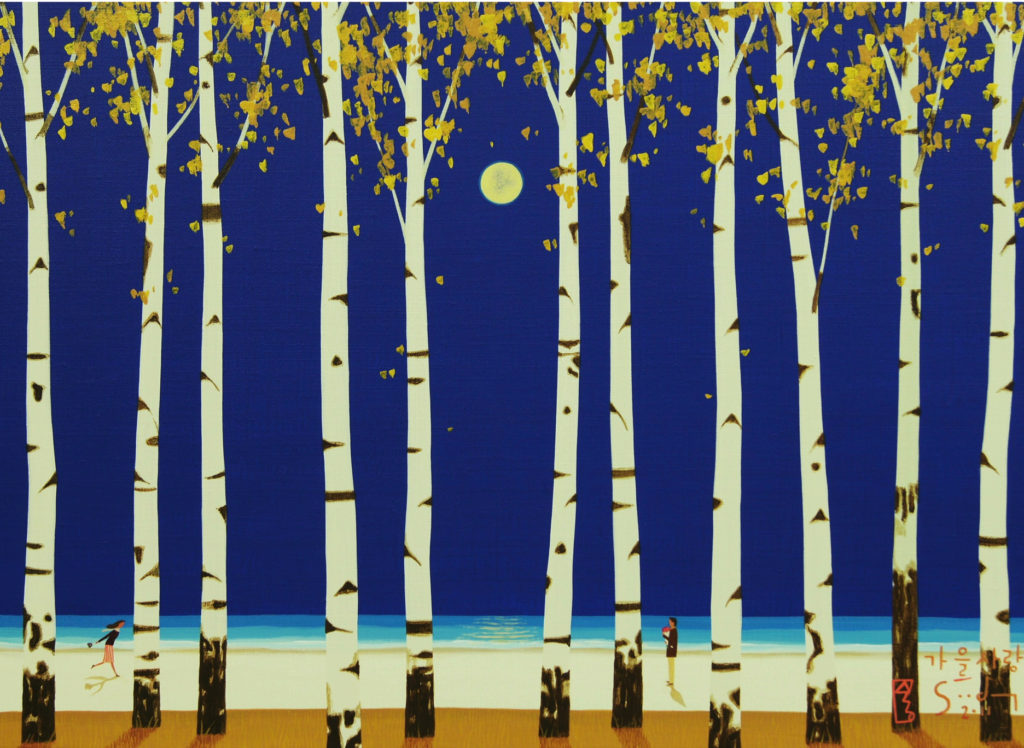

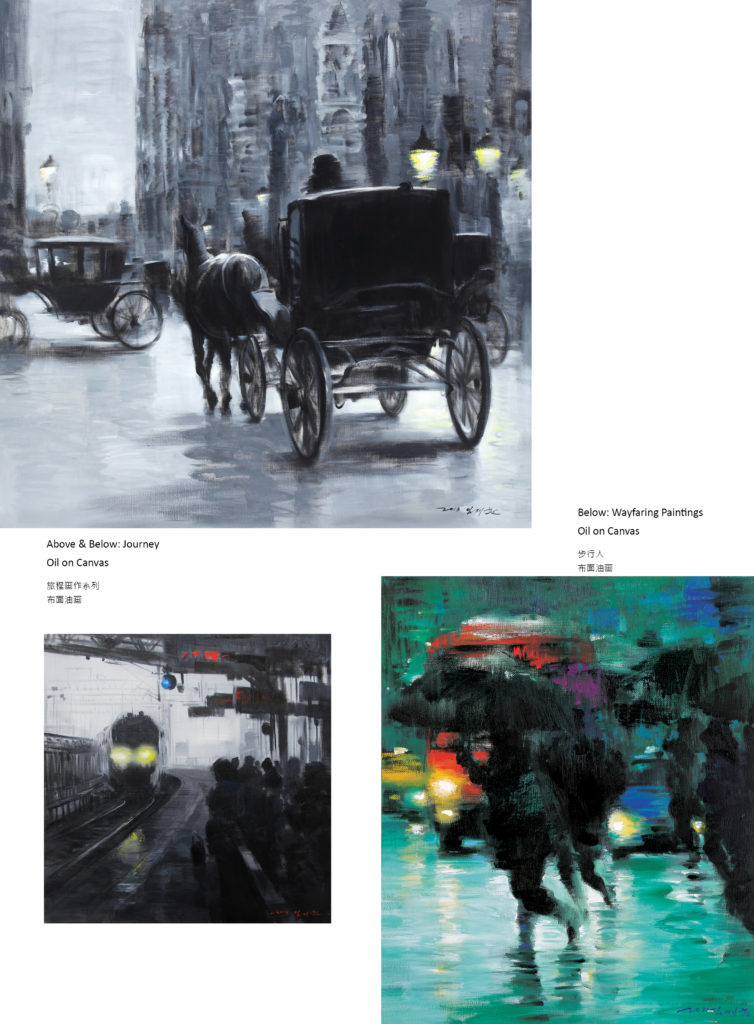
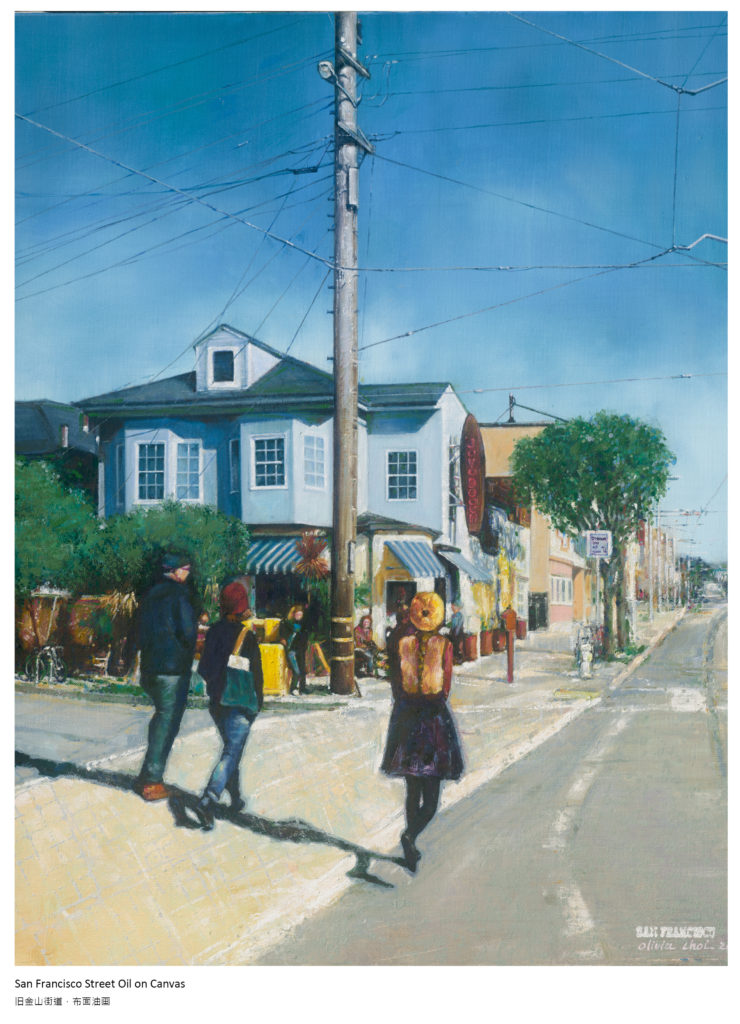
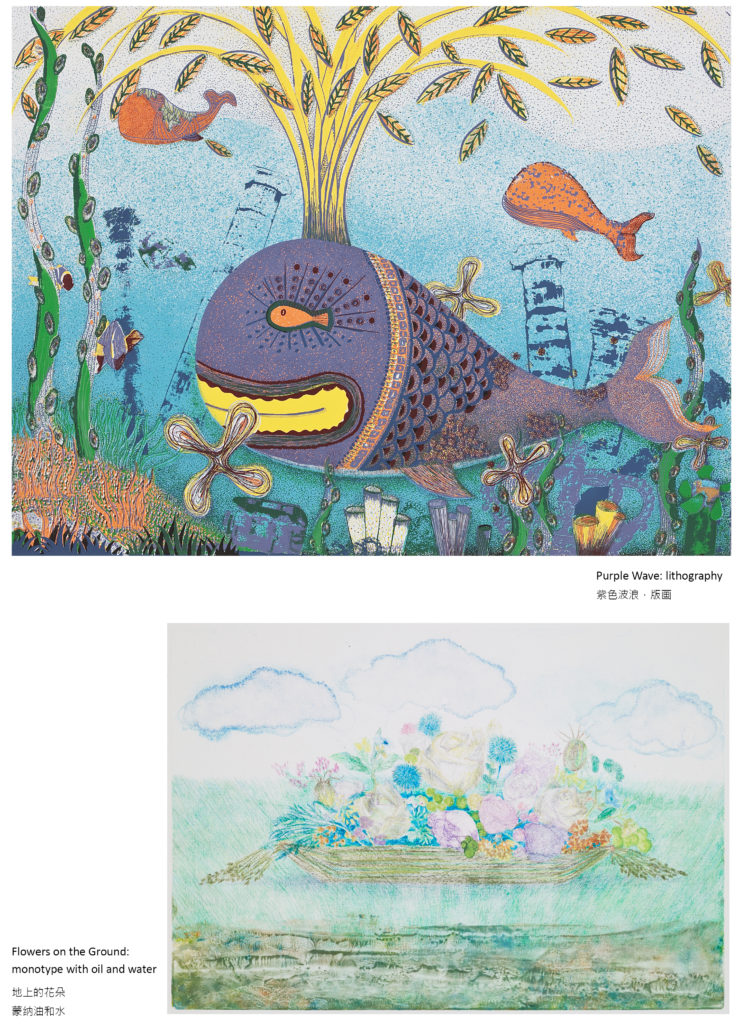
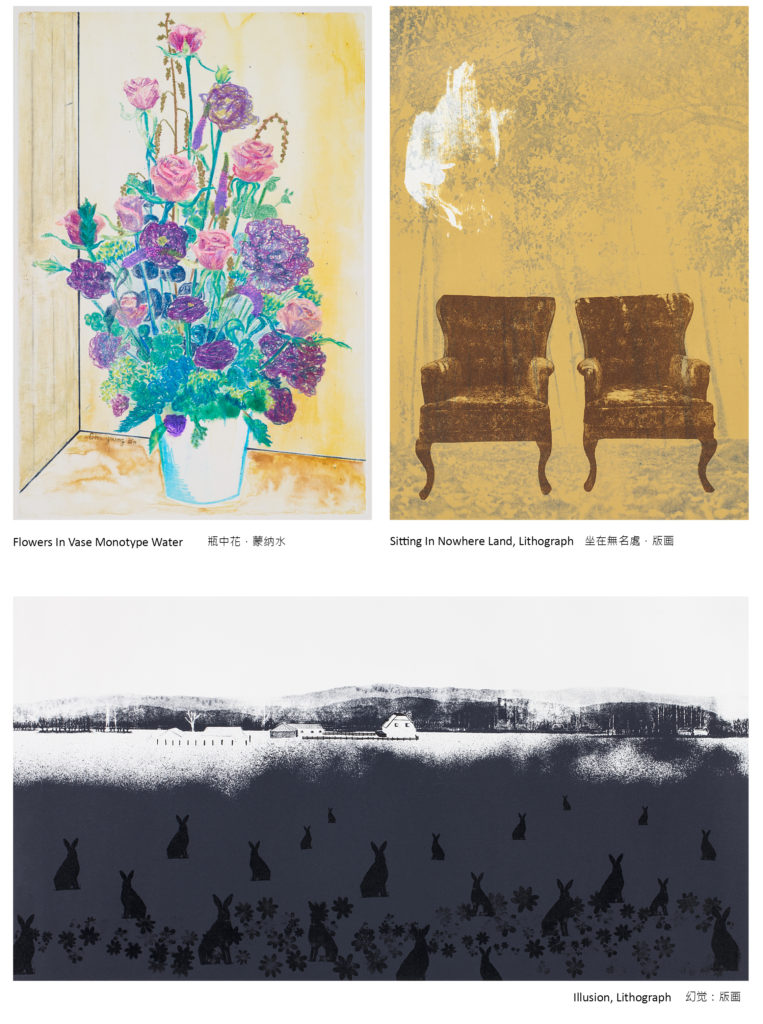
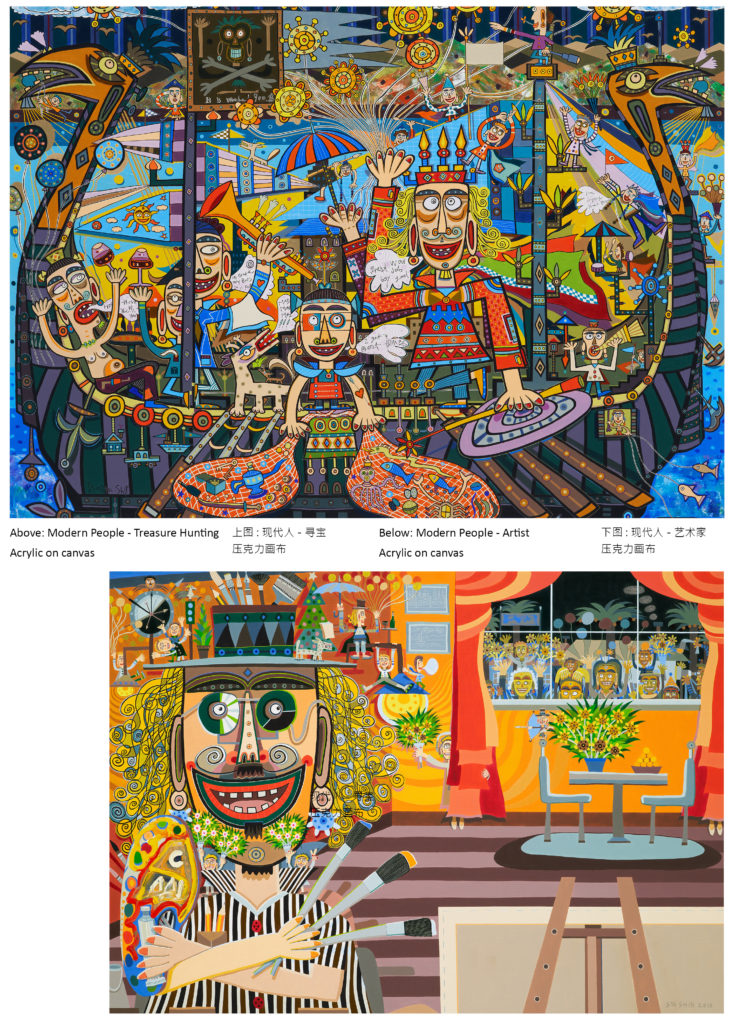

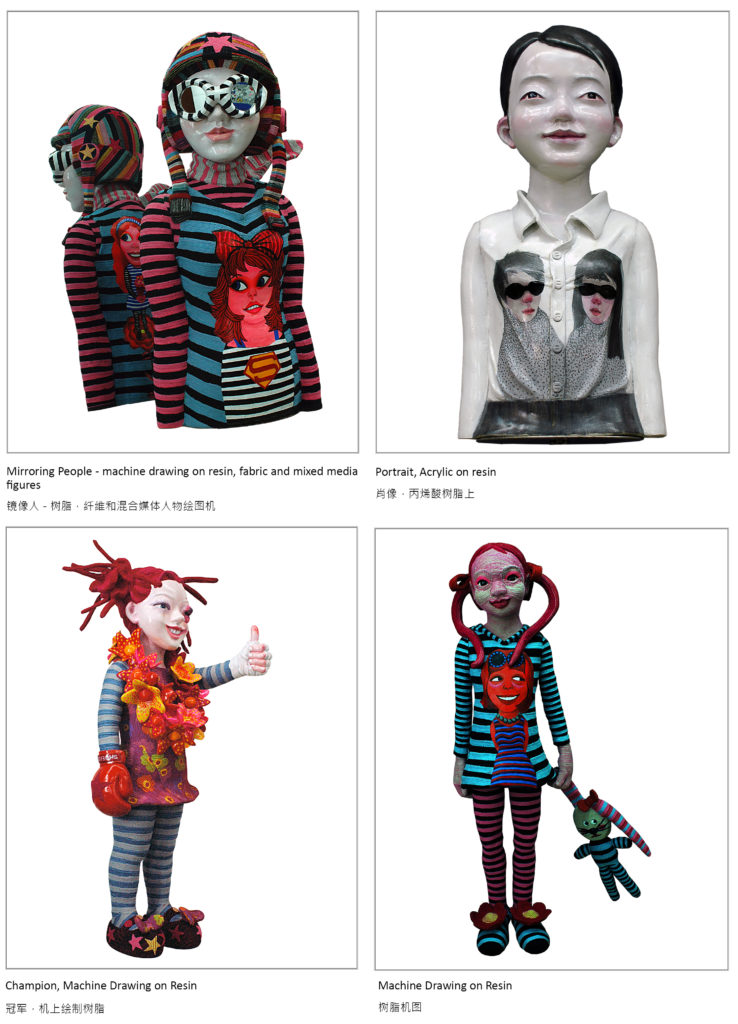
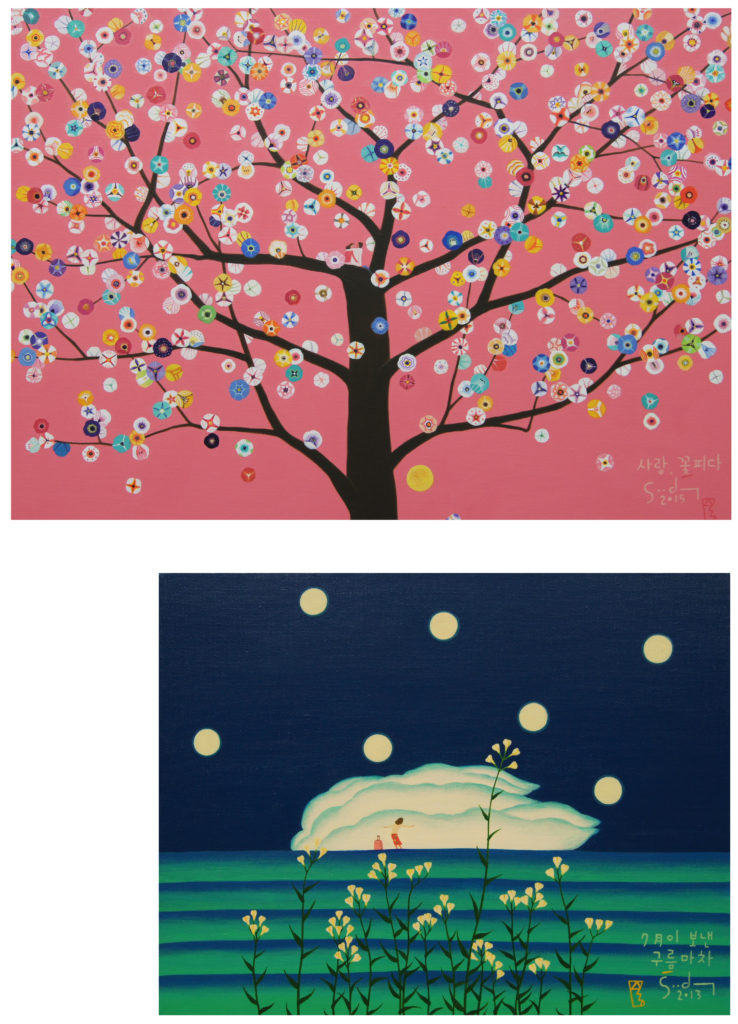



Be the first to comment